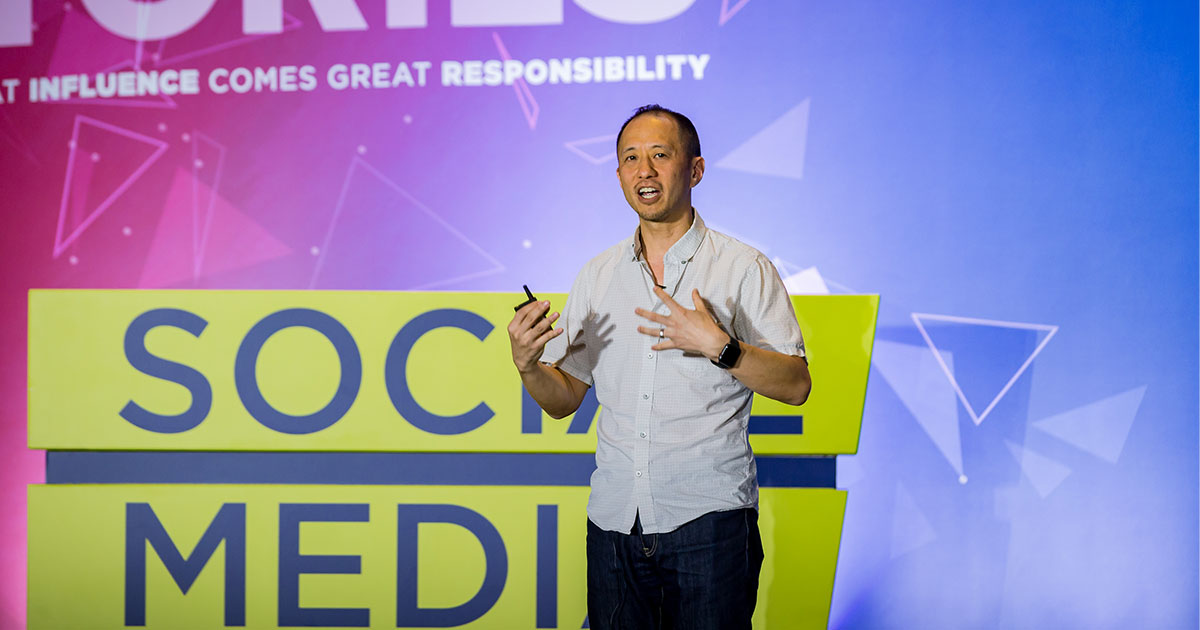
This article was originally published on the #SMW Blog
Between Instagram stories, Facebook Live, and short doc-style YouTube videos, compelling, high-quality and action-packed storytelling has taken new life, becoming more visual–and shareable–than ever.
Jason Hsiao, Chief Video Officer and Co-founder of Animoto, shared best practices for going visual in his #SMWNYC session, Successful Video Marketing: Inspiration, Trends & Best Practices for Storytelling on Social.
Successful Video Hinges on Authenticity vs. Perfection
“People use each platform differently and this should inform how we create our content,” said Hsiao when addressing #SMWNYC attendees on the importance of video.
How can companies stand out in the vast, ever-changing video world?
“I believe that video is the most compelling and effective way to communicate what’s important — to engage, educate, demo, announce, feature, showcase, fight misinformation, and inspire,” said Hsiao. “To communicate the story of you and your brand.”
Why video?

According to Animoto, with social media, people simply watch more videos than anything else — from challenges and makeup tutorials to funny cats and travel recaps. They are 6 times more likely to recall information shown in a video, 12 times more likely to share on social media (than through text), and they are 64 percent more likely to actually make a purchase.
Whether it’s an explainer video, a testimonial, or an editorial piece, “video is the most compelling and effective way to reach a diverse audience.”
How do I visually tell a story?
Every company should first ask what their purpose is, define their personal story, and the message or lesson they want to share, all before creating and sharing a video that showcases products or services.
What does my company believe? Why do people love us/our products? What do we care about most?
“Asking yourself these questions is a great place to start,” said Hsiao.
Video viewing behavior differs across platforms

Don’t just plaster the same video content over different social platforms, because each are different, Hsiao also advised. Don’t just plaster the same content on all the content. Facebook is not Instagram, is not Twitter is not YouTube. Users go to each platform–especially between mobile or desktop–for different reasons.
Facebook, the biggest platform with an average of 1.5 billion daily active users, emphasizes what’s new, hip and happening. While people are endlessly scrolling through their feeds, Facebook videos are typically kept short with no audio, utilizing captions (most people on Facebook don’t watch full videos with sound!).
Instagram, the second most popular social platform, has a much younger audience. At least 200 million people visit at least one business profile a day. And Instagram videos–often inserted into the feed as not-so-subtle ads–often drive purchases.
“Instagram stories are cost-effective, and they have also really changed the game. Feed and story content is very different, and both should inform how we create content differently,” said Hsiao. “Feed content last forever and is evergreen, more “perfect,” and is your official brand. Stories, on the other hand, are more experimental. Find something that’s really innovative and creative, and that’s how you can truly stand out.”
Twitter emphasizes what’s current or happening now, and utilizes video much less. Meanwhile, people tune in to YouTube–the original search engine for longer video content–to learn something new.
“What’s inherent to all of these is that people use each platform differently and this should inform how we create our content.”
How do you “speak” video?

Video is not just a checklist item on marketing checklist — it’s a form of regular communication, a language, with your audience. The same way brands regularly use email, blog posts, or social media to talk to consumers.
Companies can regulate this communication using compelling visuals that educate, explain, inform, and inspire.
Create content that reels people in, and keeps them watching beyond the first few seconds. The “climax,” or best parts of the video, should happen right at the start.
Authenticity is more important than perfection, and Animoto studies show that people prefer the organic, “homemade” videos over polished prototypes.
“Video can be used for every part of the customer journey, getting the stranger to become the visitor, the lead to become the customer, and to retain the customer to become the loyalist.”
Join 100,000+ fellow marketers who advance their skills and knowledge by subscribing to our weekly newsletter.
WATCH OUR SMWLA 2019 PROMO
